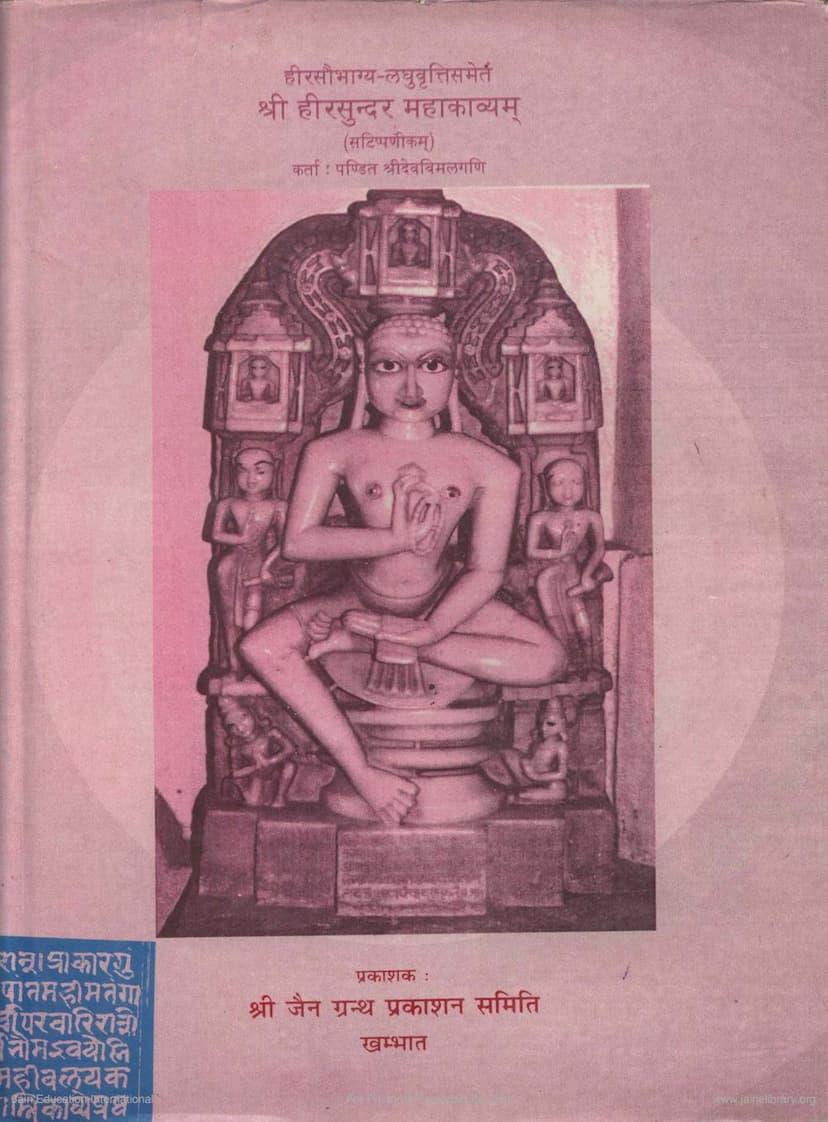Hirsundaramahakavyam Part 1
Added to library: September 1, 2025

Summary
Here's a comprehensive summary of the provided Jain text, focusing on the content of the Hirsundaramahakavyam Part 1:
HirsundaramahakThe provided text is the first volume of the Hirsundaramahakavyam, authored by Pandit Shri Devvimal Gani and edited by Muni Ratnakirtivijay. Published by Shri Jain Granth Prakashan Samiti, Khambhat, in 1996 (V.S. 2052), this volume is dedicated to the 400th death anniversary of Jagadguru Shri Hiravijaysurishwarji Maharaj.
Key Aspects and Content:
-
Purpose and Dedication: The publication of this Mahakavya is timed to commemorate the 400th death anniversary of the revered Jain Acharya, Jagadguru Shri Hiravijaysurishwarji Maharaj. The publishers express their gratitude and pride in undertaking this endeavor, highlighting Khambhat's historical significance in relation to the Jagadguru.
-
Authorship and Content: * Mahakavya: The work itself is identified as Shri Hir Sundar Mahakavyam. * Commentary: It includes a commentary (Satippanik) and a concise commentary (Laghu Vritti) on Hirasaugabhya. This indicates that Hirasaugabhya is considered a sequel or a subsequent version of Hir Sundar. * Pandit Shri Devvimal Gani: The original author of the Mahakavya is Pandit Devvimal Gani. * Muni Ratnakirtivijay: The editor who meticulously compiled and presented this volume, following the guidance of Acharya Shri Vijayshilchandra Suri.
-
Content of Part 1: The first part of the Hirsundaramahakavyam contains the first eight chapters (Sargos) of the Mahakavya. The introduction (likely by the editor or publisher) also delves into:
- Jagadguru Hiravijaysurishwarji Maharaj: His greatness is highlighted as an influential religious figure and a gifted Jain Acharya of the 16th century. His life and actions are described as filled with non-violence, compassion, and a desire for universal welfare. His ability to unite different factions (within and outside his own sect) and his firm, decisive leadership style are noted, earning him respect even from opponents.
- The Mahakavya "Hirasaugabhya": This work is described as a significant and brilliant composition, following the tradition of ancient Sanskrit Mahakavyas. It consists of seventy chapters, approximately 10,000 verses, and includes a self-commentary. The Mahakavya is placed in the same league as classical works like Magha and Naisadha, praising the poetic genius of its author, Pandit Devvimal Gani.
- "Hir Sundar" as a Precursor: The text explains that "Hir Sundar" is considered the earlier avatar or draft of Hirasaugabhya. Evidence for this includes various manuscripts of Hirasaugabhya that are titled "Hir Sundar Kavya," and some drafts of Hir Sundar show variations in text and readings compared to Hirasaugabhya. It's suggested that the author might have changed the name later, perhaps inspired by "Soma Saudbhagya," for greater aesthetic appeal, or to immortalize his mother, Saudbhagyadevi.
- Manuscript Details: The publication primarily used a manuscript from the Bhavnagar Jain Tapā Gachch Jain Sangha's Jñānabhandār. Other manuscripts were also consulted. The manuscript from the Idar Jain Sangh is particularly noted as being in the author's own handwriting, containing original verses and variant readings in the margins.
- Tika (Commentaries): The author, Pandit Devvimal Gani, remarkably composed three distinct commentaries on this single work, which is considered an exceptional feat in literary history. The first is a brief commentary on "Hir Sundar," the second is the Laghu Vritti on Hirasaugabhya (the manuscript of which was found in Ahmedabad), and the third is the detailed Brihad Vritti available in the printed version of Hirasaugabhya.
-
Content of the First Volume: Part 1 specifically includes:
- The original text of "Hir Sundar" (chapters 1-8).
- The commentary on these chapters.
- The Laghu Vritti on Hirasaugabhya.
- Appendices:
- Appendix 1: Readings from the Idar manuscript of "Hir Sundar," which contains authorial notes and variant readings.
- Appendix 2: An alphabetical index of verses from chapters 1-8 of "Hir Sundar."
-
Significance and Study: The introduction emphasizes that the Mahakavya contains a wealth of material for study from various perspectives: religious, social, cultural, geographical, linguistic, comparative, rhetorical, and literary. It specifically points out the numerous examples and quotations from various texts cited by the author and the use of contemporary colloquial language.
In essence, Hirsundaramahakavyam Part 1 is a scholarly presentation of an ancient Sanskrit epic poem detailing the life and glory of Jagadguru Shri Hiravijaysurishwarji Maharaj, offering critical editions, commentaries, and supporting material for deeper understanding and appreciation of both the work and its subject.